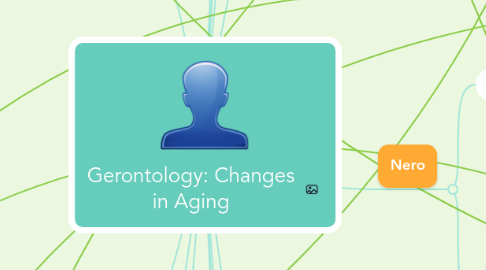
1. Respiratory
1.1. Oxygen requirements do not change
1.1.1. Sedentary lifestyle = risk for respiratory depression
1.1.1.1. Increased risk for pneumonia
1.1.1.1.1. Penicillins
1.1.2. Increased residual capacity & reduced vital capacity
1.1.2.1. High risk for infection
1.2. Calcification of costal cartilage and trachea
1.2.1. rib cage more rigid
1.3. Reduction of cough and laryngeal reflexes
2. Lydia Miller
3. Demographics
3.1. Gender
3.1.1. Male
3.1.1.1. Typically shorter life expectancy
3.1.1.2. Decline in testosterone
3.1.2. Female
3.1.2.1. Typically longer life expectancy
3.1.2.2. Effects of Aging
3.1.2.2.1. Menopause beginning in 50s
3.2. Education
3.2.1. US Census 2010
3.2.1.1. Majority (36.4%) High school graduate
3.2.1.2. 20.6% Some college/Assoc. Degree
3.2.1.3. 22.5% Bachelor's or Higher Degree
3.2.1.4. 20.5% Incomplete High school (no diploma) or less education
3.2.2. Adapt education planning based on geriatric patient's baseline
3.3. Socialization
3.3.1. Isolation
3.3.1.1. Rapid decline in health
3.3.1.1.1. Depression
3.3.1.1.2. Loss of sense of well-being
3.3.1.1.3. Sedentary/inactive
3.3.1.2. Maybe be involuntary
3.3.1.2.1. Ageism
3.3.1.2.2. Loss of spouse, family & friends
3.3.1.2.3. Uneducated or unadapted on modern technology or ways of living
3.3.1.2.4. Hearing or vision declination
3.3.1.3. Risk for developing delirium
3.3.2. Strong family & friend circle
3.3.2.1. Thrive in environments
3.3.2.2. Increased sense of well-being
3.3.3. Role Changes
3.3.3.1. Grandparenting
3.3.3.1.1. Adapt to active lifestyles
3.3.3.2. Loss of spouse
3.3.3.2.1. Performing ADLs alone
3.3.3.2.2. Single income
3.3.3.2.3. Loss of intimacy
3.3.3.3. Retirement
3.3.3.3.1. Role in society
3.3.3.3.2. Sense of identity
3.4. Interests
3.4.1. Active lifestyle
3.4.1.1. Frequent exercise/activity
3.4.1.2. Weekly social groups
3.4.1.3. Frequent visits with friends and family
3.4.1.4. Maintain mental acuity
3.4.2. Inactive
3.4.2.1. 2 hrs complete bedrest = decline in body
3.4.2.1.1. Risk for impaired skin integrity
4. Cardiac & Circulatory
4.1. Decreased proficient circulation
4.1.1. Heart muscle loses efficiency & contractile strength
4.1.1.1. Reduced cardiac output w/ physiologic stress
4.1.1.1.1. Harder to maintain BP
4.1.1.2. Valves become thick and rigid
4.1.1.3. Blood vessels reduce elasticity
4.1.1.4. O2 used less efficiently
4.1.1.5. Baroreceptors less responsive
4.1.1.5.1. Reduced compensation during activity
4.2. Heart dimensions = unchanged
5. Cellular
5.1. Body composition
5.1.1. Less lean muscle mass
5.1.2. Increased subcutaneous fat
5.1.3. Loss of tissue elasticity
5.2. Immunosenescence
5.2.1. Presbycusis
5.2.2. Presbyesophagus
5.2.3. Presbyopia
5.3. Functional cell number decreases
5.4. Fluid Composition
5.4.1. Extracellular fluid remains constant
5.4.2. Intracellular fluid reduces
5.4.2.1. Easily dehydrated
5.4.2.1.1. Increased risk for Delirium
5.4.2.2. Create electrolyte imbalances
5.5. Lose ability for cell mediated defense
5.5.1. Increased risk for infection
6. Gastrointestinal
6.1. Decreased proper processing of food
6.1.1. Decreased pepsin
6.1.2. Decreased peristalsis
6.1.3. Presbyesophagus
6.1.3.1. Increased risk for aspiration
6.1.4. Atrophy of small and large intestines
6.1.4.1. Decreased proper nutrient uptake
6.1.4.1.1. Need for diet changes to include lacking nutrients
6.1.4.1.2. Take oral supplements
6.1.4.1.3. Indigestion & constipation
7. Sleep
7.1. Pattern
7.1.1. Circadian Rhythem
7.1.1.1. Cycle changes
7.1.1.1.1. Early to bed & early to rise
7.1.1.1.2. Less time in REM
8. Nero
8.1. Changes
8.1.1. Demylenization
8.1.2. Lacking exercise = increased free radicals
8.1.3. Slowing of central processing
8.1.4. Reduction in neurons, nerve fibers and cerebral blood flow
8.1.4.1. Slower response to change in balance
8.1.5. Hypothalamus less effective in temperature regulation
8.1.6. Changes in sleep pattern w/ waking often
8.2. Decline in weight and blood flow to brain
8.2.1. Maintain mental acuity
8.2.1.1. Until around 80s
8.2.1.2. Verbal skills intact
8.2.1.3. Intelligence
8.2.1.3.1. Crystallized
8.2.1.3.2. Fluid
9. Endocrine
9.1. Decreased parathyroid secretions
9.1.1. Reduced calcium production
9.2. Decreased ACTH
9.2.1. Decreased BP
9.3. Thyroid gland atrophies
9.3.1. Basal Metabolic Rate lowers
9.3.1.1. Gain weight easier
9.3.1.2. Cannot thermoregulate as well
9.3.1.2.1. Tend to be colder
9.3.1.2.2. Cannot withstand drastic temperature changes
9.4. Beta cells in pancreas become less effective in secreting insulin
9.4.1. Decrease sensitivity to insulin & glucose
9.4.1.1. Cannot deliver glucose successfully to cells
9.4.1.1.1. Possibly lead to Type 2 Diabetes
9.4.1.1.2. Inability to sustain homeostasis of glucose
10. Musculoskeletal
10.1. Loss of lean body mass (Sarcopenia)
10.1.1. Increased risk for fragility
10.1.1.1. Combat with regular aerobic and resistance/low weight workouts
10.2. Increase in subcutaneous fat
10.3. Shift in distribution of weight
10.3.1. Become more top-heavy
10.3.1.1. Increased instability
10.3.1.1.1. Increased risk of falls
10.4. Decrease flexibility
10.5. Thinning disks & shortened vertebrae
10.6. Decreased bone and mineral mass
10.6.1. Diminished calcium absorption
10.6.1.1. Increased risk of fractures
10.6.1.2. Increase diet or supplementation of calcium
11. Safety
11.1. Pharmaceutical
11.1.1. Manage Drugs & Interactions
11.1.1.1. Polypharmacy
11.1.1.1.1. Try to prevent w/ adaptations to lifestyle
11.2. Mobility
11.2.1. Limited activity
11.2.1.1. Decreased lean muscle
11.2.1.2. Limited mobility
11.2.1.3. Struggle with rapid movements & reactions
11.2.1.3.1. Increased fall risk
11.2.1.4. Increased risk for fractures
11.2.1.4.1. Common sites: Hips, Pelvis, Wrist, Radius
11.2.1.4.2. Increase calcium intake
12. Reproductive
12.1. Male
12.1.1. BPH develops in about half of aging men
12.1.1.1. Harms sexual activity with vasoconstriction of vessels
12.1.2. Rate of sperm cell productive slows
12.2. Female
12.2.1. Decreased vaginal lubrication
12.2.2. pH of vagina becomes alkalotic
12.2.2.1. Increase risk of UTI
12.2.3. Vulva atrophies & labia flatten
13. Pharmaceutics
13.1. Polypharmacy
13.1.1. Patient taking more than 6 drugs at once
13.1.1.1. Increased risk for interactions & contraindications
13.2. Common drugs
13.2.1. Anti hypertensives
13.2.1.1. Beta blockers
13.2.1.2. Diuretics
13.2.1.3. ACE inhibitors
13.2.2. Antiinfectives
13.2.2.1. Penecillins
13.2.2.2. Vancomycin
13.2.3. Glucose control
13.2.3.1. Insulins
13.2.3.2. Oral glucose regulators
13.2.4. Supplements
13.2.4.1. Calcium, Potassium, Iron
14. Renal
14.1. Reduced renal blood flow & GFR
14.2. Reduced bladder capacity
14.2.1. Increased urgency & frequency
14.2.1.1. BPH compression increases urgency to urinate
14.2.2. Nocturia
